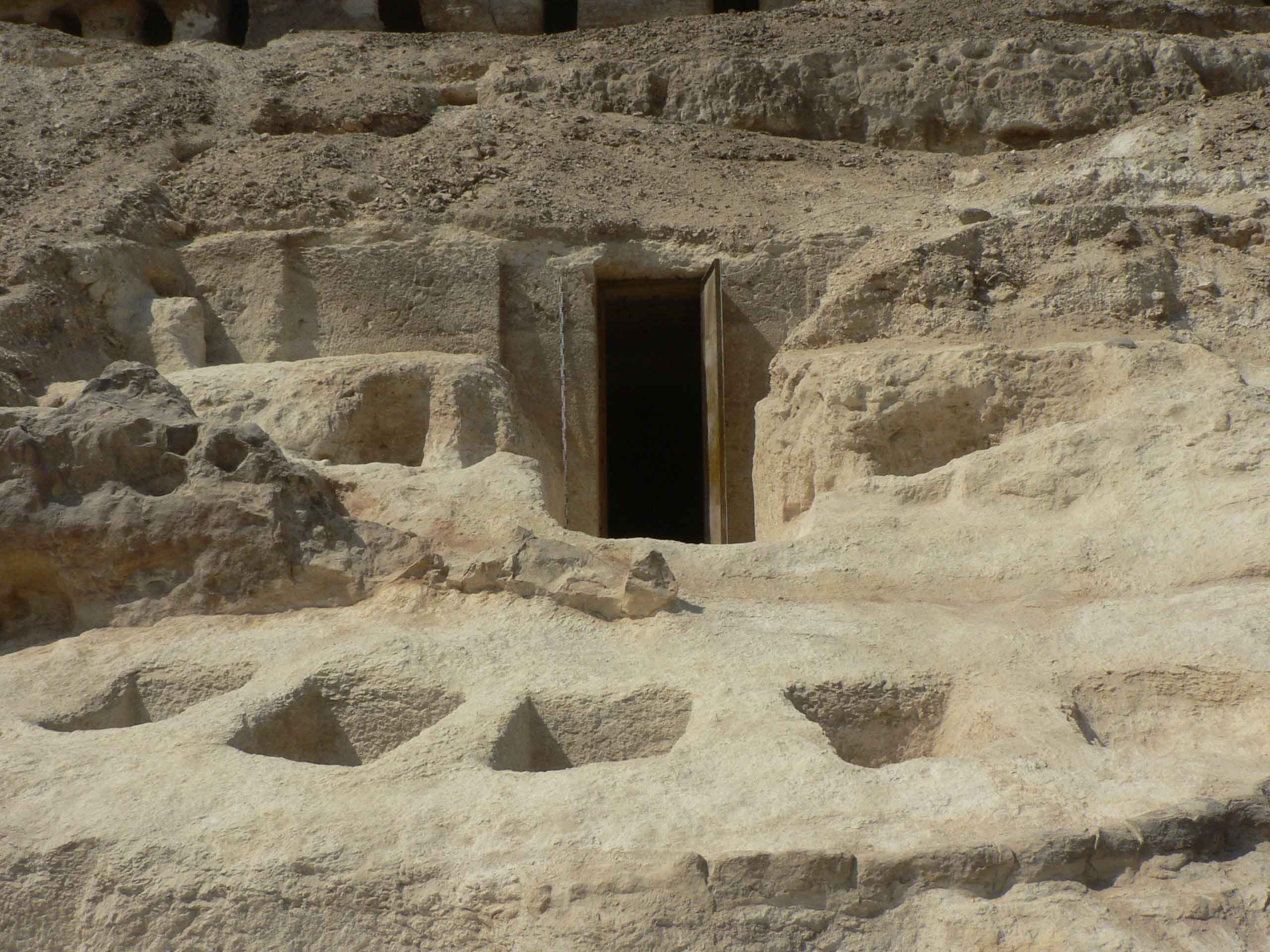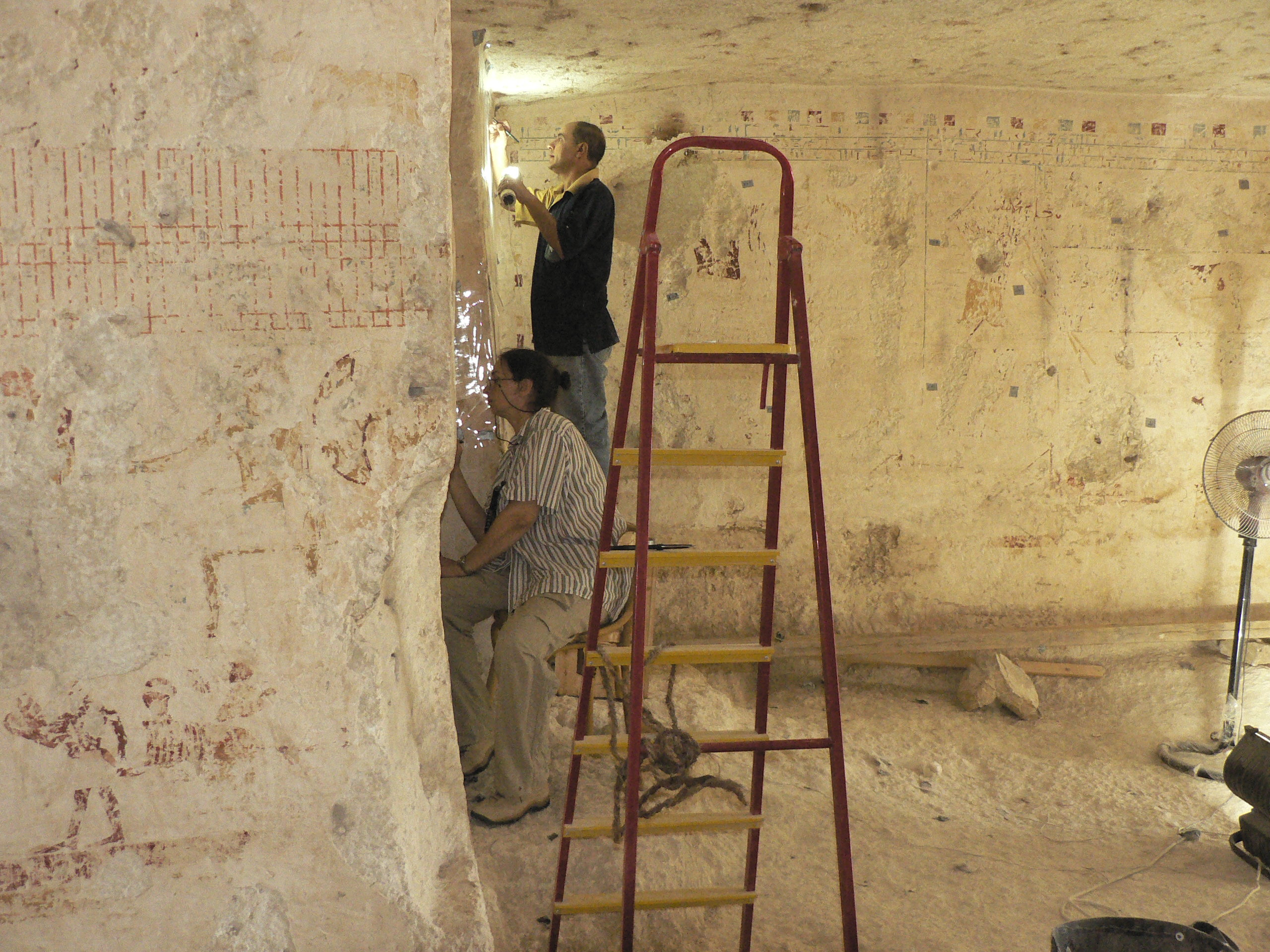Click here for English version
Click here for Japanese version: 近年発見されたN13.1号墓
Etwa 30 m oberhalb des großen Grabes III wurde am Ende der Kampagne von 2005 ein bislang völlig unbekanntes Grab entdeckt, das die Nummer N13.1 erhielt. Es gehört einem Gaufürsten der 11. Dynastie namens Iti-ibi(-iqer) (ca. 2000 v. Chr.). Das Felsgrab mit annähernd quadratischem Grundriss besitzt drei Schächte, zwei Pfeiler und eine Nische in der Westwand, die Wände waren vollständig dekoriert.

Auf der Terrasse vor dem Grabeingang wurden zahlreiche Schächte freigelegt, die z.T. noch ungestörte Bestattungen vom Ende des Alten Reiches bis ins Mittlere Reich enthielten. Die nach Osten blickenden, in seitlicher Hockerstellung liegenden Leichname verschiedenen Alters und Geschlechts waren in Körben, Matten oder Holzsärgen beigesetzt, als Beigaben fanden sich vor allem Kopfstützen, Gefäßständer, Näpfe und auch Früchte.
Etwa 500 Jahre nach Fertigstellung des Grabes begann man, zwischen den Darstellungen der ursprünglichen Dekoration handschriftliche Texte und Zeichnungen zu hinterlassen, insgesamt über 200 Tuschegraffiti (Dipinti) aus der 18.-20. Dynastie. Darunter finden sich Motive von Menschen, Tieren und Göttern, Besucherinschriften, historische Vermerke, Opfertexte sowie zahlreiche und teils umfangreiche Auszüge von berühmten literarischen Werken wie diverse Lehren, der Nilhymnus, die Rede des Neferti, die in der Epoche des Neuen Reiches als Schultexte verwendet wurden.
Publikationen siehe unten.

Approximately 30 m above the large Tomb III, a totally unknown tomb was discovered and assigned the number N13.1 at the end of the 2005 fieldwork. It belongs to an 11th Dynasty Nomarch Iti-ibi (-iqer) (ca. 2000 BC). The rock cut tomb with an almost quadrate plan has threee shafts, two pillars and a niche in the western wall. The walls were fully decorated.
On the terrace in front of the tomb, numerous shafts were cleared, some of which contained still undisturbed burials dating from the end of the Old Kingdom until the Middle Kingdom. The corpses of different ages and gender facing east and lying lateral in contracted position were buried in baskets, mats or wooden coffins. Grave goods included headrests, pottery and also fruits.
Around 500 years after the completion of the tomb, a total of more than 200 ink graffiti (dipinti) from the 18-20th Dynasty had been left. They were drawn respecting the original decorative texts and drawings. The graffiti included drawings of human beings, animals and gods, visitors' graffiti, historical notes, offering texts and many and partly extensive passages from famous literary works like teachings, hymn to the Nile, speech of Neferti, which were used as school texts in the New Kingdom.
Publication of the shafts in front of Tomb N13.1:
M. Becker, Work on the finds from the shaft burials from Stage 7 in the magazine of Shutb, in: J. Kahl et al., The Asyut Project: Eleventh Season of Fieldwork (2014), in: SAK 44, 2015, 139-144.
Publications of the original decoration of Tomb N13.1:
M. El-Khadragy, Tomb N13.1 of the Nomarch Iti-ibi(-iqer) at Asyut; with collaboration of Ulrike Dubiel and Eva Gervers, The Asyut Project 17, Wiesbaden 2022.
M. El-Khadragy, Some Significant Features in the Decoration of the Chapel of Iti-ibi-iqer at Asyut, in: SAK 36, 2007, 105-135.
Publications of the dipinti of the New Kingdom and Islamic Times in Tomb N13.1:
U. Verhoeven, A Step Back into the Past: New Kingdom Scribal Activities in the Necropolis of Asyut, in: Ch. Ragazzoli, Kh. Hassan, Ch. Salvador (eds.), Graffiti and Rock Inscriptions from Ancient Egypt. A Companion to Secondary Epigraphy, Bibliothèque d'étude 182, Kairo 2023, 239-254.
U. Verhoeven, The Second Half of the “Teaching of Hardjedef” – In Fact Well Known, in: Ola El-Aguizi, Burt Kasparian, Hgg., ICE XII. Proceedings of theTwelth International Congress of Egyptologists, 3rd-8th November 2019, Cairo, Egypt, Part VI, Bibliothèque générale 71, Kairo 2023, 887-892.
U. Verhoeven (ed.), Dipinti von Besuchern des Grabes N13.1 in Assiut, 2 Bde. (Text und Tafeln), The Asyut Project 15, Wiesbaden 2020:
- Teil 1: Besuchertexte, Lehren und Lieder des Neuen Reiches, von Ursula Verhoeven, unter Mitarbeit von Svenja A. Gülden;
- Teil 2: Zeichnungen von Besuchern des Neuen Reiches, von Eva Gervers;
- Teil 3: Texte und Zeichnungen aus islamischer Zeit, von Youssef Ahmed-Mohamed.
U. Verhoeven, Literatur im Grab - Der Sonderfall Assiut, in: G. Moers et al. (Hgg.), Dating Egyptian Literary Texts, Lingua Aegyptia - Studia Monographica 11, Hamburg 2013, 139-158 (mit 6 Farbtf.).
U. Verhoeven, The New Kingdom Graffiti in Tomb N13.1: An Overview, in: J. Kahl, M. El-Khadragy, U. Verhoeven, A. Kilian, Hgg., Seven Seasons at Asyut. First Results of the Egyptian-German Cooperation in Archaeological Fieldwork. Proceedings of an International Conference at the University of Sohag, 10th-11th of October, 2009, The Asyut Project 2, Wiesbaden 2012, 47-58, pl. 1-4.
U. Verhoeven, Von der „Loyalistischen Lehre“ zur „Lehre des Kairsu“ - Eine neue Textquelle in Assiut und deren Auswirkungen, in: Zeitschrift für Ägyptische Sprache und Altertumskunde 136/1, 2009, 87-98 mit Tf. XII.
U. Verhoeven, Die wie Kraniche balzen. Männerphantasien zur Zeit Amenhoteps III. in Assiut, in: D. Kessler et al., Hgg., Texte - Theben - Tonfragmente. Festschrift für Günter Burkard, ÄAT 76, Wiesbaden 2009, 434-441.
J. Kahl & U. Verhoeven, „Dornröschen“ ist erwacht, Das neu entdeckte Grab N13.1 in Assiut, in: Sokar 16, 2008, 68-73 mit Abb. 1-10.
J. Kahl, Ancient Asyut. The First Synthesis after 300 Years of Research, The Asyut Project 1, Wiesbaden 2007, 79-82. with fig. 32, 57-62, pl. 5a-b, 14a.
J. Kahl, Ein Zeugnis altägyptischer Schulausflüge, in: GM 211, 2006, 25-29.
